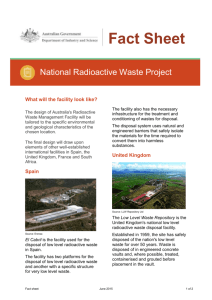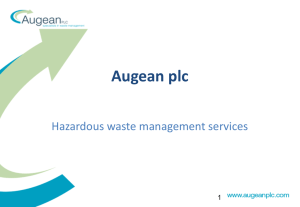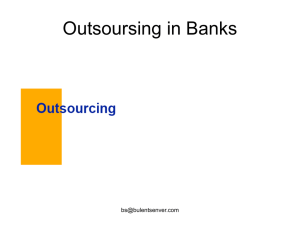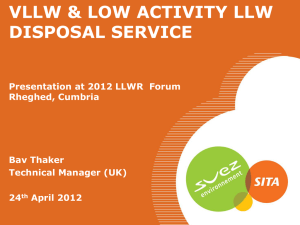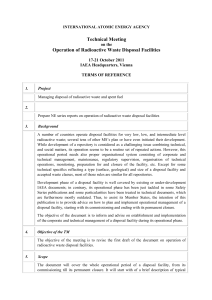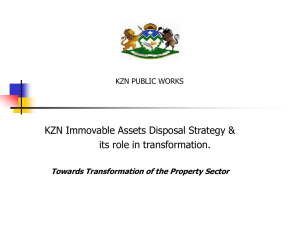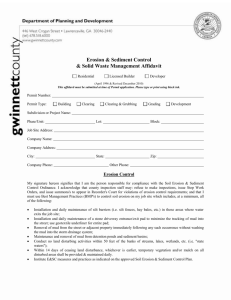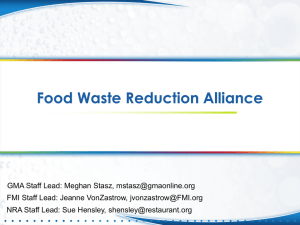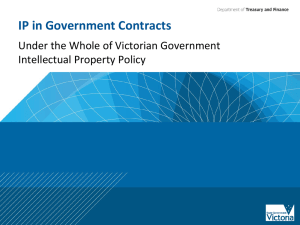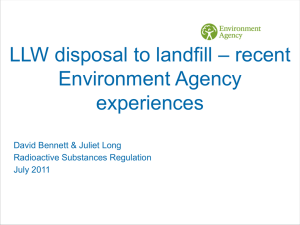An Introduction to Waste
advertisement
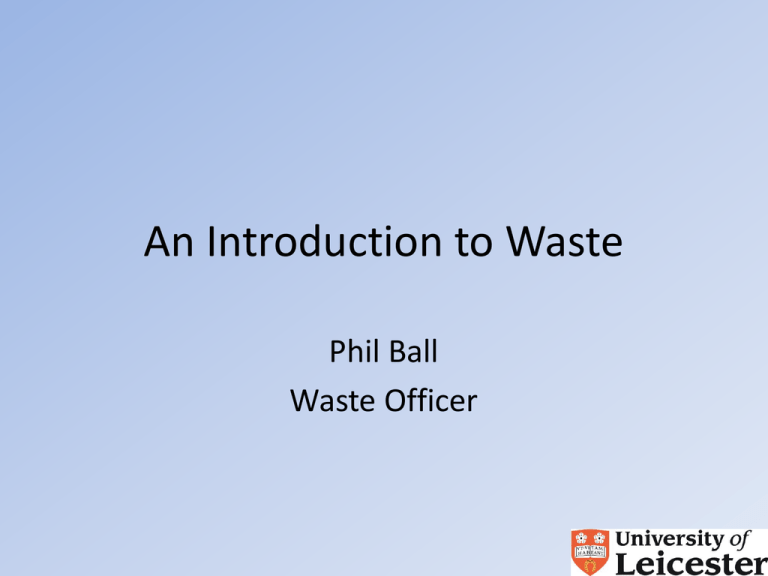
An Introduction to Waste Phil Ball Waste Officer Overview • Why Manage Waste? – Legal compliance – Economic value – Environmental value • Background to Waste Management – Introduction – Roles and responsibilities • What is Waste? – Key legal definitions for HEIs – Classification of waste – European waste catalogue (EWC) • Legislation – Introduction – Requirements of the Environmental Protection Act 1990 – Requirements of the Environmental Protection (Duty of Care) Regulations 1991 • Waste transfer processes • Site Waste Management Plans • Summary Why Manage Waste? • Legal Compliance – Increases in the fines imposed by the courts for waste management offences – High level of publicity surrounding a number of recent cases – Universities and colleges are no exception. – A number of universities have already received warnings in relation to waste management offences. Why Manage Waste? • Economic Value – Landfill tax increases every year. – We produce over 2500 tonnes of waste annually. – Add service costs to this and landfill becomes very expensive! Year Tax per tonne 2013 £72 2012 £64 2011 £56 2010 £48 2009 £40 2008 £32 2007 £24 – Recycling take back schemes exist for certain types of waste (e.g. batteries & flourescent tubes). Signing up to these can also save a lot of money. Why Manage Waste? • Environmental Value – The environmental impacts associated with waste mainly result from its disposal. Waste minimisation reduces the environmental damage caused. – Raw materials have a finite supply – waste can be used as a resource. – Emphasis of waste management policy at a National and European level is on reducing the amount of waste produced and keeping materials in circulation for as long as possible. Background to Waste Management Introduction It is important to have a basic understanding of what waste is and to be aware of the types of waste stream that you are likely to encounter. How waste is classified is largely based on its properties, but there are a series of legal definitions which you will need to be familiar with if we are going to manage our waste effectively in line with statutory requirements. Background to Waste Management Roles and Responsibilities • Waste Producer – The person who made the substance become waste e.g. by breaking or contaminating it. – The person who decided that a substance was unwanted and therefore waste. Our Duty of Care is to make sure waste leaves our site legally. Background to Waste Management • The Environment Agency – As waste regulator, the Environment Agency has responsibility for enforcing waste management legislation. – This includes the licensing of sites and waste carriers and ensuring compliance with legislation. Background to Waste management • Waste Carriers – Waste carriers must be licensed to carry waste on behalf of the waste producer – Shanks, who take the vast majority of the University’s waste, are an example of a licensed waste carrier Background to Waste Management • Waste Disposal Authorities – Local authorities are also responsible as Waste Disposal Authorities (WDAs) for ensuring the provision of disposal facilities in their area for controlled waste. – Since 1990, these facilities must be run either by the private sector or by a Local Authority Waste Disposal Company (LAWDC) rather than by the local authority itself. What is Waste? • Legal Definition of Waste ‘Anything which you decide to, or are required to, throw away.’ What is Waste Key legal definitions for HEIs • CONTROLLED WASTE – Waste that is defined as household, industrial or commercial waste, including special and clinical waste. – The University could be classified as a producer of household and commercial waste. • CLINICAL WASTE – Any waste consisting wholly or partly of tissue, body fluids, excretions, drugs or other pharmaceutical products, swabs or dressings, or sharp instruments, being waste which unless rendered safe may prove hazardous or infectious to any person coming into contact with it. What is Waste? • SPECIAL/HAZARDOUS WASTE – Controlled waste that, because of its properties, requires special treatment and control. • RADIOACTIVE WASTE – Radioactive waste is defined in the Radioactive Substances Act 1993 as any waste which: • consists wholly or partly of substance which would otherwise be classified as a radioactive material • any substance contaminated by a radioactive material or radioactive waste. – It should be noted that some radioactive waste may also be classified as hazardous/special waste. What is Waste • Classification of waste – Most of the materials discarded from FHE establishments are classified as controlled waste. The management and disposal of controlled waste is principally regulated by the Environmental Protection Act 1990. What is Waste? • The European Waste Catalogue (EWC) – The European Waste Catalogue contains a hierarchical list of waste descriptions, each of which is assigned a numeric code. – The Waste Management Licensing Regulations 1994 contain a list of substances and objects that are legally considered to be waste. Legislation • Introduction – Waste management in the UK is controlled by legislation that is driven by and transposes European Directives and Regulations. – The UK national controls on waste originated from the Control of Pollution Act 1974 and were strengthened by the introduction of the Environmental Protection Act 1990. – Operational legislation covers the disposal, storage, treatment, recycling and transport of waste. – Administration legislation controls storage, registration, licensing, monitoring and record keeping. Legislation • REQUIREMENTS OF ENVIRONMENTAL PROTECTION ACT 1990 – While on site, waste must be stored in such a way as to prevent it from causing damage to the environment or posing a risk to human health. – When disposing of waste, check that it is being disposed of at a properly licensed/permitted site and in accordance with the conditions of the licence/permit for that site. – Ask to see a copy of the operating licence/permit and conditions for the site to which your waste is taken. – It is also the responsibility of the producer of the waste to ensure that enough information about the nature of the waste is provided to ensure that licence/permit conditions are met. – Section 34 of the EPA 90 imposes a Duty of Care on all those who import, produce, carry, keep, treat or dispose of controlled waste. Legislation • REQUIREMENTS OF ENVIRONMENTAL PROTECTION (DUTY OF CARE) REGULATIONS 1991 • Ensure that your waste is properly stored while on the premises and that it is adequately packaged for transportation. The Duty of Care requires that waste be kept safe against: – Corrosion and wear of waste containers – Accidental spillage or leaking – Accident or weather breaking contained waste open and allowing it to escape. – Waste blowing away while stored or transported e.g. open skips – Scavenging of waste by vandals, thieves, children, trespassers or animals. Legislation • It should be remembered that the Duty of Care applies to all controlled waste including materials sent for recovery, reuse and recycling. – All waste must be accurately labelled and, – Accompanied by an accurate description of the waste. Legislation Arrangements for the transfer of waste • Select an authorised person to take the waste. Waste, including materials collected for recycling, must only be transferred to an authorised person, i.e. – A Waste Collection Authority. – A Registered Waste Carrier or an Exempt Waste Carrier. – A holder of a Waste Disposal or Waste Management Licence or persons exempt from the need for a licence. Legislation • Where waste is passed on to an intermediate transferee it is prudent to check that the waste is being disposed of in an appropriate manner. – As a minimum, find out from your waste carrier how and where your waste will be disposed of. • Complete a Transfer Note for the waste and ensure that it is signed by the waste carrier. The responsibility to ensure that a Transfer Note is completed lies with the waste producer. The description of the waste and the Transfer Note must be handed over with the waste and must accompany the consignment. • Ensure that a copy of the transfer note and corresponding waste description are kept for 2 years. Legislation Site waste management plans (SWMP) – Construction projects over £300,000 must have a basic SWMP – Construction projects over £500,000 must have a detailed SWMP • Breach of the Regulations is an offence punishable – (a) on summary conviction, by a fine not exceeding £50,000, or – (b) on conviction on indictment, by a fine. Summary • If something is deemed to be surplus to requirements, it is waste. • Waste must be kept under reasonable control whilst on site. • Waste must be disposed of with a licensed company/individual – checking this is the responsibility of the waste producer. • A waste transfer note must accompany each consignment of waste and be kept on file for 2 years (send a copy to the Waste Officer for filing) • If in doubt, consult the Waste Officer!! Common Waste Licences • Waste Carrier’s Licence – Any person/company who transports waste between sites requires a WCL • Waste Broker’s Licence – Any person/company who sub-contracts waste removal requires a WBL • Environmental Permit (waste management licence – WML) – Any site that carries out waste disposal or recovery activities requires a Permit e.g. a waste transfer station Thank you Any questions? Remember: If in doubt, seek Phil out…
